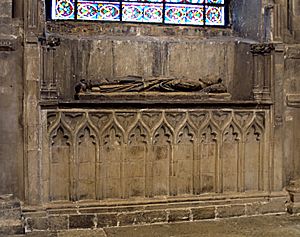Walter Reynolds facts for kids
Quick facts for kids Walter Reynolds |
|
|---|---|
| Archbishop of Canterbury | |
| Appointed | 1313 |
| Enthroned | January 1314 |
| Reign ended | 16 November 1327 |
| Predecessor | Thomas Cobham |
| Successor | Simon Mepeham |
| Other posts | Bishop of Worcester |
| Orders | |
| Consecration | 13 October 1308 |
| Personal details | |
| Died | 16 November 1327 |
Walter Reynolds (who died in 1327) was an important figure in medieval England. He served as the Bishop of Worcester and later became the Archbishop of Canterbury from 1313 to 1327. He also held powerful government jobs, including Lord High Treasurer and Lord Chancellor.
Contents
Early Life and Career
Walter Reynolds was the son of a baker from Windsor, Berkshire. He started his career as a clerk or chaplain working for King Edward I.
Reynolds quickly gained favor, especially with the Prince of Wales, who later became King Edward II. He was known for his skills and became a close friend of the prince. He even served as the prince's Keeper of the Great Wardrobe, managing his personal belongings and expenses.
Soon after Edward II became king, Walter Reynolds was given a very important job. On August 22, 1307, he was made the Treasurer of England. This meant he was in charge of the country's money.
Becoming a Bishop
On November 13, 1307, Walter Reynolds was chosen to be the Bishop of Worcester. He was officially made a bishop on October 13, 1308. As bishop, he had religious duties and also helped manage a school that later became the Royal Grammar School Worcester.
He continued to rise in government. On July 6, 1310, he was named Keeper of the Great Seal and Lord Chancellor of England. These roles meant he was a top legal and administrative official for the king.
Walter Reynolds was also chosen for a special honor: he was one of the godfathers for the future King Edward III. This prince was christened on November 17, 1312.
Archbishop of Canterbury
When the Archbishop of Canterbury, Robert Winchelsea, passed away in May 1313, King Edward II wanted his friend Walter Reynolds to take the position. The king convinced Pope Clement V to appoint Reynolds.
In January 1314, Walter Reynolds was officially made the 51st Archbishop of Canterbury at Canterbury Cathedral. This was a very powerful religious role in England.
Challenges and Reforms
As Archbishop, Reynolds tried to make some important changes and improvements within the church. He also continued a long-standing disagreement between the Archbishops of Canterbury and York about who had more authority.
For example, in 1317, he placed London under an interdict. This meant that many church services were temporarily stopped in the city. He did this after William de Melton, the Archbishop of York, walked through London with his cross held high, which was seen as a challenge to Canterbury's authority.
Loyalty and Change
Walter Reynolds generally remained loyal to King Edward II for many years. However, in 1324, he and other bishops disagreed with the king. They stood up for Bishop of Hereford, Adam Orleton, whom the king was opposing.
Later, Reynolds had more disagreements with Edward II over church rules. When Queen Isabella rebelled against the king, Reynolds supported her. He even sent her money.
He had to flee to Kent for safety during this time. But he soon returned to London and declared his support for Edward III, the new king. Walter Reynolds had the honor of crowning Edward III on February 1, 1327. He was also made a member of the regency council, a group that helped rule the country for the young King Edward III.
In 1327, Reynolds helped make the idea of vox populi, vox Dei popular in England. This Latin phrase means "the voice of the people is the voice of God." He used this idea in a speech when making accusations against Edward II.
Walter Reynolds passed away at Mortlake on November 16, 1327.


